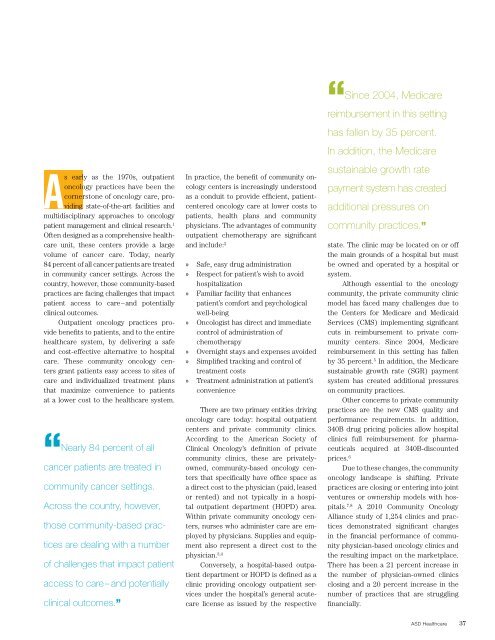media - ASD Healthcare
media - ASD Healthcare
media - ASD Healthcare
Create successful ePaper yourself
Turn your PDF publications into a flip-book with our unique Google optimized e-Paper software.
As early as the 1970s, outpatientoncology practices have been thecornerstone of oncology care, providingstate-of-the-art facilities andmultidisciplinary approaches to oncologypatient management and clinical research. 1Often designed as a comprehensive healthcareunit, these centers provide a largevolume of cancer care. Today, nearly84 percent of all cancer patients are treatedin community cancer settings. Across thecountry, however, those community-basedpractices are facing challenges that impactpatient access to care – and potentiallyclinical outcomes.Outpatient oncology practices providebenefits to patients, and to the entirehealthcare system, by delivering a safeand cost-effective alternative to hospitalcare. These community oncology centersgrant patients easy access to sites ofcare and individualized treatment plansthat maximize convenience to patientsat a lower cost to the healthcare system.“Nearly 84 percent of allcancer patients are treated incommunity cancer settings.Across the country, however,those community-based practicesare dealing with a numberof challenges that impact patientaccess to care – and potentiallyclinical outcomes.”In practice, the benefit of community oncologycenters is increasingly understoodas a conduit to provide efficient, patientcenteredoncology care at lower costs topatients, health plans and communityphysicians. The advantages of communityoutpatient chemotherapy are significantand include: 2»»Safe, easy drug administration»»Respect for patient’s wish to avoidhospitalization»»Familiar facility that enhancespatient’s comfort and psychologicalwell-being»»Oncologist has direct and im<strong>media</strong>tecontrol of administration ofchemotherapy»»Overnight stays and expenses avoided»»Simplified tracking and control oftreatment costs»»Treatment administration at patient’sconvenienceThere are two primary entities drivingoncology care today: hospital outpatientcenters and private community clinics.According to the American Society ofClinical Oncology’s definition of privatecommunity clinics, these are privatelyowned,community-based oncology centersthat specifically have office space asa direct cost to the physician (paid, leasedor rented) and not typically in a hospitaloutpatient department (HOPD) area.Within private community oncology centers,nurses who administer care are employedby physicians. Supplies and equipmentalso represent a direct cost to thephysician. 3,4Conversely, a hospital-based outpatientdepartment or HOPD is defined as aclinic providing oncology outpatient servicesunder the hospital’s general acutecarelicense as issued by the respective“Since 2004, Medicarereimbursement in this settinghas fallen by 35 percent.In addition, the Medicaresustainable growth ratepayment system has createdadditional pressures oncommunity practices.”state. The clinic may be located on or offthe main grounds of a hospital but mustbe owned and operated by a hospital orsystem.Although essential to the oncologycommunity, the private community clinicmodel has faced many challenges due tothe Centers for Medicare and MedicaidServices (CMS) implementing significantcuts in reimbursement to private communitycenters. Since 2004, Medicarereimbursement in this setting has fallenby 35 percent. 5 In addition, the Medicaresustainable growth rate (SGR) paymentsystem has created additional pressureson community practices.Other concerns to private communitypractices are the new CMS quality andperformance requirements. In addition,340B drug pricing policies allow hospitalclinics full reimbursement for pharmaceuticalsacquired at 340B-discountedprices. 6Due to these changes, the communityoncology landscape is shifting. Privatepractices are closing or entering into jointventures or ownership models with hospitals.7,8 A 2010 Community OncologyAlliance study of 1,254 clinics and practicesdemonstrated significant changesin the financial performance of communityphysician-based oncology clinics andthe resulting impact on the marketplace.There has been a 21 percent increase inthe number of physician-owned clinicsclosing and a 20 percent increase in thenumber of practices that are strugglingfinancially.<strong>ASD</strong> <strong>Healthcare</strong> 37






